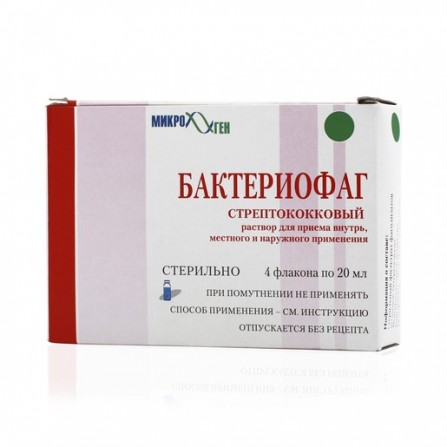Streptophagous Bacteriophage streptococcal liquid 20 ml 4 pcs
Condition: New product
999 Items
Rating:
Be the first to write a review!

More info
Active ingredients
Streptococcal bacteriophage
Release form
Solution
Composition
In one vial means Streptococcal bacteriophage contains 20 ml of sterile phagolysate of streptococcal strains. The additional substance is 8-hydroxyquinoline sulfate monohydrate.
Pharmacological effect
Antibacterial specific action.
Pharmacokinetics
Peculiarities of pharmacokinetics have not been studied.
Indications
Therapy and prevention of diseases caused by strains of the genus Streptococcus in the composition of multicomponent therapy: lesions of the digestive tract (intestinal dysbacteriosis, gastroenterocolitis, cholecystitis), diseases of the newborn purulent-inflammatory nature (gastroenterocolitis, omfalitis, pyoderma, sepsis, conjunctivitis,), for example, gastroenterocolitis, seizis, conjunctivitis, inflammation, neoplasm, pyoderma, septicemia, cholecystitis wounds, paraproctitis, osteomyelitis, panaritiums, mastitis, carbuncle, phlegmon, boils, burns, pleurisy, abscess); urogenital infections (pyelonephritis, cystitis, urethritis, colpitis, endometritis, salpi) ngooforitis); diseases of the ear, nose, throat, respiratory tract and lungs (sore throat, otitis media, laryngitis, pharyngitis, pneumonia, bronchitis, pleurisy); generalized septic lesions; other diseases associated with streptococcus; prevention of hospital infections associated with streptococcus.
Contraindications
Sensitization to the drug.
Use during pregnancy and lactation
Use of the drug is allowed under the supervision of a physician.
Dosage and administration
The instruction allows the use of the drug inside, in the form of irrigation, applications, enemas, introduction into the nasal cavity, wounds, uterus, vagina, sinuses, and also for drainage of cavities. Recommended dosages for patients older than 8 years are up to 30 ml of solution (oral administration) and up to 50 ml (administration in the form of enemas). Treatment of localized diseases of purulent-inflammatory nature should be carried out by combining local treatment and taking the drug orally for 1-3 weeks. Depending on the nature of the infection, the agent can be applied in the following ways: In the form of lotions, plugging and irrigation in an amount up to 200 ml. With an abscess after emptying its cavity, the drug is administered orally in a smaller amount than the amount of pus removed.When treating osteomyelitis, 10-20 ml of the agent is injected into the wound after surgical treatment. When injected into the pleural, articular, or other confined cavities, capillary drainage is established, by means of which the drug is administered in 100 ml for several days. . In the case of drainage of the pelvis of the kidney or bladder, the drug is administered through a stoma twice a day, 30-40 ml into the cavity of the bladder or 6-7 ml into the renal pelvis. When gynecological lesions of a purulent-inflammatory character are injected into the uterus or vagina, 7-10 ml every day. With colpitis - irrigation of 10 ml or plugging twice a day for 2 hours. In case of diseases of the throat, ear and nose of a purulent-inflammatory nature, the agent is administered 2-10 ml up to three times a day. Bacteriophage is used for washing, instillation, rinsing, administering turunda for 1 hour. For intestinal dysbacteriosis and enteric infections, the drug is taken orally three times a day one hour before meals for 1-3 weeks. The combination of double oral administration with a joint rectal administration of an age dose once a day in the form of an enema after defecation is also permitted. The use of the drug in children younger than 6 months, including premature babies. up to three times a day. It is also possible to apply through the mouth by mixing with breast milk. The treatment lasts up to 15 days. In order to prevent enterocolitis, sepsis during intrauterine infection or the risk of nosocomial infection in newborns, the drug is used twice a day in the form of enemas throughout the week. a napkin twice a day.
Side effects
Not found.
Overdose
Such cases are not described.
Interaction with other drugs
The drug is allowed to combine with anti-inflammatory and antibacterial agents. If antiseptics were used for the treatment before using the bacteriophage, then the wound should be washed with sodium chloride solution.
special instructions
Before use, the bottle with the drug must be shaken and its transparency and the presence of sediment should be evaluated. If turbidity or sediment is detected, the drug should not be used! Due to the presence in the preparation of a favorable climate for the development of microorganisms from the environment that cause clouding of the solution, the vial should be opened according to the following rules: hands should be thoroughly cleaned; the cap should be removed without removing the stopper; the preparation from the opened container should be removed only by piercing the stopper with a sterile syringe; if during the opening together If a stopper was accidentally uncorked with a cap, it should not be placed on the inner surface of the table, and the vial should not be left open (after withdrawing the agent it should be closed with a stopper); the opened vial should be stored in the refrigerator. If these rules are observed and there is no turbidity, It is allowed to use the opened bottle during the whole shelf life period. Children Standard doses of the drug for children up to 6 months are 5 ml when taken orally and 10 ml when used as an enema; for children 6-12 months - 10 ml when administered orally and 20 ml when used as an enema; for children 1-3 years old - 15 ml when taken orally and 20-30 ml when used as an enema; for children 3-8 years old - 20 ml when administered orally and 30-40 ml when used as an enema. In children older than eight years, use adult doses of the drug. For newborns, the standard dose for newborns is 5 ml of the drug when taken orally and 10 ml when used as an enema.






